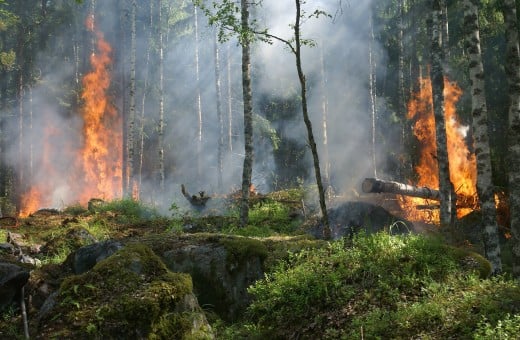
Northern California is currently battling its most deadly wildfire ever, called the Camp Fire.
As of yesterday, 56 people have died in its flames. But as these deaths settle into the broken hearts of their loved ones, so settles a gloomy smoke over neighboring cities.
Officials are concerned about the health risks that smoke could bring.
According to reporters Ben Guarino and Zara Stone of The Washington Post, the initial smoky aftermath moved San Francisco’s air quality levels to just above hazardous (1).
The quality has improved a little but not enough for health officials to deem it safe.
You see, most people don’t worry themselves over what a fire’s smoke can do to their lungs. However, New York State’s Department of Health points out just
how harmful that smoke can be (2).
Depending on where smoke comes from, it can contain all sorts of harmful chemicals, burnt vegetation and soot. Aldehydes, sulfur dioxides and metals are a few to watch for.
What health officials are really worried about, though, is the small particulate matter.
The smallest particles are the most dangerous to people’s health, and these are commonly emitted from smoke caused by fire. These particles are called PM2.5. Particles this size can’t be seen with the naked eye, but they can do a lot of damage.
The tiny particles can burrow deep into a person’s lungs, says the New York health department. In effect, they can cause breathing problems for young children and the elderly. They exacerbate developing or already weakened respiratory systems (2).
However, these groups aren’t the only ones at risk. Environmental epidemiologist Ralph Delfino told The Washington Post that the people most at risk are those with heart problems or lung disease (1).
These people may have to address breathing issues at the hospital.
Even still, perfectly healthy people will feel some effects if the smoke is heavy enough.
According to the CDC, locals might experience stinging eyes, scratchy throats, sinus problems and fatigue, among more serious symptoms (3).
The New York health department advises people to steer clear of situations like the smoke coming from Camp Fire or the Woolsey Fires (2).
But in California’s case, that’s a hard thing to do when the thick haze is looming over your own backyard.
Ralph Borrmann is a public information officer who works with the Bay Area Air Quality Management District. You’d find air quality this bad in Beijing, Borrmann told Wired (4).
If the wind blows the smoke further out, the problem of California’s poor air quality may worsen. Mix that with tall city buildings that trap smoke in, and you’ve got a recipe for
air quality disaster.
So what should residents do?
“Individuals are advised to limit their physical exertion if exposure to high levels of smoke cannot be avoided,” says the NY health department (2).
Health officials closer to the California fires are saying the same thing. People should avoid going outdoors as much as possible.
In short, forget outdoor activities for a while, especially if you’re a child, elderly person or have health problems.
The CDC also advises people to use an air filter inside their homes. In addition, they should turn air conditioners to a refilter setting so that low-quality air isn’t pulled in from
outside (3).
The situation surrounding California’s wildfires is a devastating one. There’s no doubt about that.
For now, all locals can do is heed the health warnings. Everyone else should keep those affected in their thoughts and prayers.
Sources:
1. Guarino, B., Stone, Z., & Morrar, S. (2018, November 14). California’s deadliest wildfire is also a massive air-quality problem. The Washington Post. Retrieved from
https://www.washingtonpost.com/nation/2018/11/15/californias-deadliest-wildfire-is-also-massive-air-quality-problem/?utm_term=.85a3d2ac756d.
2. New York State Department of Health. (2016, October). Exposure to Smoke from Fires. Retrieved from
https://www.health.ny.gov/environmental/outdoors/air/smoke_from_fire.htm.
3. Centers for Disease Control and Prevention. (2017, November 16). Natural Disasters and Severe Weather: Wildfire Smoke.
Retrieved from
https://www.cdc.gov/disasters/wildfires/smoke.html.
4. Molteni, M. (2018, November 9). Stay Inside, Californians:Wildfire Smoke is a Big Health Risk. Wired. Retrieved from
https://www.wired.com/story/smoke-from-wildfires-is-a-growing-public-health-crisis-for-cities/.
